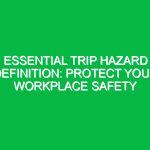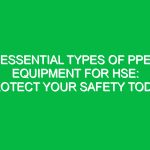Introduction
Hello team, and thank you for gathering today for this important toolbox talk. We’re here to discuss a crucial topic in the realm of Health, Safety, and Environment (HSE): “Easy Way Instead of the Right Way.” This phrase serves as a reminder that while shortcuts might seem appealing, they can lead us away from Safety and proper Procedures. Today, we’ll explore practical methods to conduct effective Toolbox Talks, emphasizing the necessity of doing things safely and correctly.
Understanding the Concept: Easy Way Instead of the Right Way
The phrase “Easy Way Instead of the Right Way” often reflects a common mindset in the workplace. It suggests that when faced with a task, some individuals may opt for the easiest method, disregarding Safety protocols. While it might save time in the short term, this approach can lead to accidents, injuries, and even fatalities. Our goal is to establish a culture that prioritizes safety and compliance over convenience.
Why Toolbox Talks Matter
Toolbox talks are brief, informal meetings held to discuss specific safety issues and enhance awareness among employees. They play a vital role in creating a safe working environment. Here are some reasons why toolbox talks are essential:
- Promotes safety awareness: Regular discussions help keep safety at the forefront of everyone’s mind.
- Encourages participation: Employees feel more engaged and valued when they can share their thoughts and experiences.
- Reduces incidents: Frequent reminders about safety practices can significantly lower the number of workplace accidents.
- Facilitates communication: Toolbox talks encourage open dialogue about safety concerns, fostering a culture of transparency.
How to Conduct Toolbox Talks Effectively
Conducting an effective Toolbox Talk is crucial in cementing safety practices in our daily operations. Here are some easy ways to ensure that your toolbox talks hit the mark:
1. Plan Ahead
Before the Toolbox Talk, prepare a clear agenda. Choose a specific topic relevant to the team’s current tasks or recent incidents. For example, if our crew is about to work on scaffolding, focus the talk on scaffolding safety. This preparation will help keep the discussion on track and meaningful.
2. Engage Your Audience
Make the Toolbox Talk interactive. Ask open-ended questions to encourage participation. For instance, ask, “What safety issues have you noticed on site?” This invites team members to share their experiences and insights, fostering a collaborative environment.
3. Use Real-Life Examples
Incorporate real-life examples or case studies to illustrate the importance of safety. For instance, discuss a recent incident from the industry where the “Easy Way Instead of the Right Way” led to an accident. Highlight what could have been done differently. This not only drives the point home but also makes the discussion relatable.
4. Keep It Short and Focused
Toolbox talks should be brief, ideally lasting around 15-20 minutes. This ensures that the information is digestible and keeps everyone’s attention. Focus on one or two key messages to avoid overwhelming your team.
5. Provide Actionable Insights
At the end of the talk, summarize key takeaways and provide actionable insights. For example, if discussing the use of Personal Protective Equipment (PPE), remind everyone of the specific gear required for their tasks and demonstrate how to wear it correctly. This reinforces the importance of safety in a practical manner.
Key Components of an Effective Toolbox Talk
To ensure that your toolbox talks are effective, consider these key components:
1. Clear Objectives
Define clear objectives for each talk. What do you want the team to learn or remember? For example, if discussing Ladder Safety, the objective may be to ensure that everyone understands how to inspect a ladder before use.
2. Visual Aids
Utilize visual aids such as diagrams, videos, or props to enhance understanding. Visuals can help illustrate complex information, making it easier for everyone to grasp the concepts discussed.
3. Follow-Up and Feedback
After the talk, solicit feedback from the team. Ask questions like, “What did you find most useful?” or “What else would you like to learn about?” This feedback is invaluable for improving future toolbox talks and ensuring that the topics remain relevant.
Recognizing the Risks of the Easy Way Instead of the Right Way
While shortcuts may seem harmless, they can lead to significant risks. Let’s explore some potential Hazards associated with taking the easy way:
1. Increased Risk of Injury
By skipping safety protocols, you increase the likelihood of accidents. For example, bypassing proper lifting techniques to save time can lead to musculoskeletal injuries.
2. Legal Consequences
Non-compliance with safety Regulations can result in legal consequences for both employees and the company. This underscores the importance of adhering to established procedures rather than opting for shortcuts.
3. Impact on Team Morale
When safety is compromised, team morale can suffer. Employees who feel unsafe or see colleagues disregarding safety procedures may become disengaged or anxious about their work environment.
Best Practices for Implementing Toolbox Talks
To successfully implement toolbox talks, consider the following Best Practices:
1. Schedule Regular Talks
Establish a consistent schedule for toolbox talks. Whether weekly or bi-weekly, regular talks create a routine that emphasizes the importance of safety.
2. Create a Safe Space for Sharing
Encourage team members to share their concerns and experiences without fear of judgment. A culture of openness promotes safety and encourages individuals to speak up if they notice unsafe practices.
3. Use a Variety of Formats
Mix up the formats of your toolbox talks. Incorporate group discussions, demonstrations, or even hands-on activities to keep the talks engaging and informative.
Regulations and Standards in HSE
Understanding the regulations and standards related to HSE is fundamental to maintaining safety. Compliance with these regulations not only protects employees but also ensures the company meets its legal obligations. Here are some key regulations to be aware of:
1. Occupational Safety and Health Administration (OSHA) Standards
osha sets forth regulations that govern Workplace Safety. Familiarize yourself with these standards relevant to your tasks, as they outline necessary safety practices.
2. Company Policies
Review and understand your company’s specific safety policies. These policies are designed to align with OSHA standards and may include additional requirements for your specific workplace.
3. Continuous Improvement
Always strive for continuous improvement in safety practices. Regularly review and update Toolbox Talk topics based on incidents, feedback, and changes in regulations.
Conclusion
In conclusion, the way we approach safety can significantly impact our work environment. By emphasizing the “Easy Way Instead of the Right Way,” we can foster a culture that prioritizes safety and compliance. Remember, toolbox talks are an essential tool in this effort. They provide a platform for communication, learning, and growth.
Thank you for your attention and commitment to safety. Let’s continue to support one another in our efforts to create a safe and healthy workplace.


